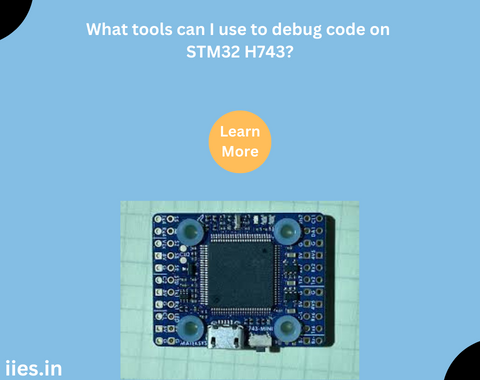
Debugging embedded systems, especially on powerful microcontrollers like the STM32 H743, requires a thorough understanding of the debugging tools and techniques available. In this article, we will explore various methods and tools to effectively debug code on the STM32 H743 microcontroller.
The STM32 H743 is a high-performance microcontroller unit (MCU) developed by STMicroelectronics, featuring an Arm Cortex-M7 core running at up to 480 MHz. It offers a wide range of peripherals and interfaces, making it suitable for a variety of applications, including industrial automation, consumer electronics, and Internet of Things (IoT) devices.
1. Integrated Development Environments (IDEs)
IDEs such as STM32CubeIDE, Keil µVision, and IAR Embedded Workbench provide comprehensive debugging features tailored specifically for STM32 microcontrollers. These IDEs offer functionalities such as source-level debugging, real-time variable inspection, and memory visualization, making it easier to identify and fix bugs in the code.
2. JTAG/SWD Debugging
STM32 H743 supports debugging through the Joint Test Action Group (JTAG) and Serial Wire Debug (SWD) interfaces. These interfaces allow developers to connect a debugger, such as ST-LINK or J-Link, to the microcontroller for real-time debugging and code inspection. Through JTAG/SWD debugging, developers can set breakpoints, step through code execution, and examine memory contents to identify and resolve issues.
3. Trace Debugging
Trace debugging enables detailed analysis of program execution flow and timing behavior. The STM32 H743 features a built-in Instruction Trace Macrocell (ITM) and Data Trace Macrocell (DTM), which allow developers to capture trace data and analyze it using trace visualization tools. Trace debugging provides valuable insights into code execution, helping to optimize performance and identify potential bottlenecks.
4. Debugging Probes
Debugging probes, such as ST-LINK and J-Link, facilitate the connection between the development environment and the target microcontroller for debugging purposes. These probes offer advanced features such as real-time trace, flash programming, and support for various debugging interfaces, making them indispensable tools for debugging complex applications on the STM32 H743.
Debugging Techniques
1. Breakpoints
Breakpoints allow developers to pause the execution of the program at specific points of interest, such as function calls or conditional statements. By setting breakpoints in the code, developers can inspect variable values, stack contents, and register states to diagnose issues and understand program behavior.
2. Step-by-Step Execution
Step-by-step execution allows developers to navigate through the code one instruction at a time, providing detailed insights into the program flow and behavior. By stepping through the code, developers can identify the sequence of instructions executed and pinpoint any deviations from the expected behavior.
3. Watchpoints
Watchpoints enable developers to monitor changes to specific memory locations or variables during program execution. By setting watchpoints, developers can detect unintended writes or accesses to critical data, helping to identify and prevent potential bugs and security vulnerabilities.
4. Real-Time Variable Inspection
Real-time variable inspection allows developers to monitor the values of variables and expressions during program execution. By observing variable values in real-time, developers can validate assumptions, detect unexpected behavior, and diagnose issues more effectively.
Best Practices for Debugging on STM32 H743
1. Understand the Hardware
Before debugging code on the STM32 H743, it is essential to familiarize yourself with the hardware architecture, peripherals, and memory map of the microcontroller. Understanding the hardware constraints and capabilities will help you optimize code performance and avoid common pitfalls during debugging.
2. Use Version Control
Version control systems such as Git enable developers to track changes to the codebase, collaborate with team members, and revert to previous versions if necessary. By using version control, you can maintain a clean and organized codebase, making it easier to debug and troubleshoot issues as they arise.
3. Modularize Code
Modularizing code into smaller, reusable components promotes code readability, maintainability, and testability. By breaking down the code into manageable modules, you can isolate and debug individual components more effectively, speeding up the development process and reducing the likelihood of errors.
4. Document Debugging Process
Documenting the debugging process, including observations, hypotheses, and solutions, can be invaluable for future reference and troubleshooting. By keeping detailed notes and documenting the steps taken to debug the code, you can streamline the debugging process and share insights with other team members.
Debugging code on the STM32 H743 microcontroller requires a combination of tools, techniques, and best practices to effectively identify and resolve issues. By leveraging integrated development environments, debugging probes, and advanced debugging techniques, developers can streamline the debugging process and ensure the reliability and performance of their embedded applications. With a thorough understanding of the hardware architecture and debugging tools available, developers can tackle even the most challenging debugging scenarios with confidence.
Indian Institute of Embedded Systems – IIES